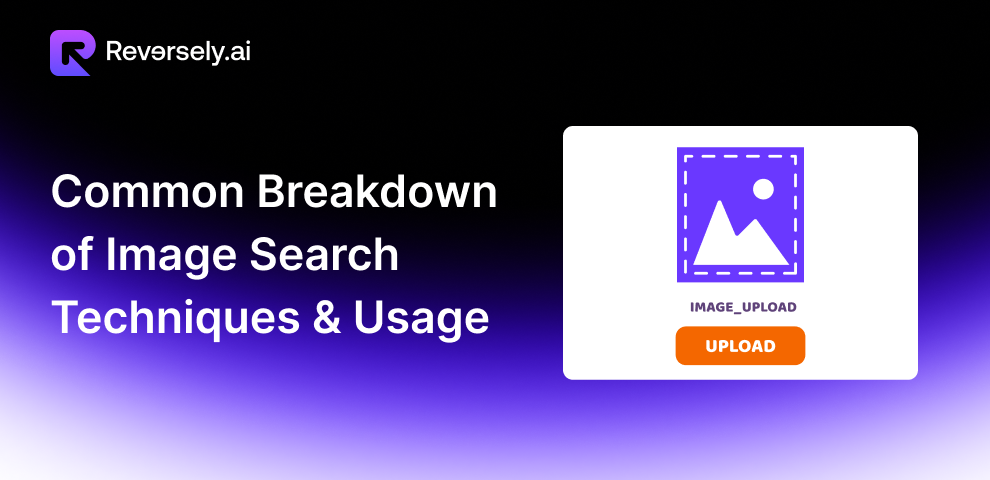
Every image online carries a story, but not all are clear. Sometimes it’s the product you hope to find, other times it’s a headline photo that feels recycled, or a stranger’s portrait appearing in the wrong setting. Image search can help you uncover those stories.
This guide takes a detailed look at how image search works, the platforms that lead in different categories, and the ways individuals and professionals can use it effectively.
Best Image Search Techniques of 2025
Reverse Image Search
Reverse image search is designed to locate websites where a particular image appears, trace its original source, or discover visually similar pictures. You can either upload an image or paste its URL into a search engine that supports this feature. The system then scans its database and returns related matches. Imagine you have a photo of an unfamiliar monument. A reverse image search can help reveal the landmark’s name, history, and location.
Popular Platforms:
- Google Images
- Reversely.ai
- Duplichecker.com
- TinEye
Keyword-Based Image Search
Not every situation allows for an image upload. In such cases, keyword search remains valuable. In this particular case, Google Images and Bing Images still dominate here.
However, the results solely rely on how well you describe the photo. And that precision comes from using specific descriptive terms. For example, instead of typing “antique clock,” type “antique brass carriage clock, France, 19th century.” Additionally, adding brand names, years, or colors helps narrow down results significantly.
Refining Image Searches with Advanced Options
Even with the right keywords, search results can be overwhelming. Search options or filters help narrow the field. For instance, you can mention the site, file, type, or add quotation marks. Here’s how you can use them:
- Site: restricts results to a single domain. For instance, site: nationalgeographic.com lion photo.
- Filetype: filters by format such as JPG, PNG, or GIF. Example: filetype: png anatomy diagram.
- Quotation Marks around keywords ensure the phrase is matched exactly.
You can also use search filters provided by search engines. These filters can further narrow down the results, helping you get the best outcome.
Creative Commons and Public Domain Sources
You can also explore Creative Commons and public domain sources to find the best image search results. These sources have libraries of millions of photos, helping you get whatever you are looking for. If reverse image search tools fail to provide accurate results, they are always there to help.
Here are some of the best sources for image search:
- Unsplash: free high-resolution photography across a wide range of categories.
- Pexels: extensive library cleared for commercial use with optional attribution.
- Wikimedia Commons: strong resource for educational, scientific, and historical images.
Specialized Image Search Engines
Certain tasks demand tools beyond Google or Bing. In such cases, you need specialized engines. These search engines are also quite beneficial for all types of users. These sources include:
- Stock Photo Libraries like Shutterstock, Getty Images, and Adobe Stoke
- Design and Creative Portfolios like Behance and Dribbble
- News and Media Archives like AP Images and Reuters Pictures
How to Improve Your Search Accuracy?
- Upload the highest quality image available.
- Test across multiple platforms, including Google, Yandex, and Reversely.ai.
- Crop images to focus only on the relevant object.
- Revisit searches over time, since databases update regularly.
Professional and Everyday Uses of Image Search
Brand Protection
Companies monitor product photos across marketplaces to catch counterfeiters. A reverse search quickly exposes listings that use stolen brand photography.
Journalism and Verification
Fact-checkers depend on reverse search to confirm if a viral photo is recent or recycled from an older event. This prevents misinformation from spreading.
Research and Education
Academics use image search to connect scattered manuscripts, identify artworks, or trace visual history. Students use it to find diagrams and accurate references.
Security and Privacy
Individuals use tools like Google or Reversely.ai to track where their personal photos appear online. This is increasingly important for preventing identity theft and fake social profiles.
Shopping and Lifestyle
Consumers snap a product, upload it, and get instant links to stores. CBIR (content-based retrieval) powers apps like Amazon StyleSnap and Pinterest Lens, making online shopping seamless.
Challenges and Limitations
Even the best image search tools face limitations:
- Incomplete databases: No engine covers the entire internet.
- Edits and modifications: Cropped or heavily altered images can evade detection.
- Bias in recognition: Facial recognition tools sometimes underperform across demographics.
- Privacy and legality: Using recognition tools on strangers may be restricted by law.
Being aware of these boundaries helps avoid overreliance.
Conclusion
At its core, image search is about connecting pictures with context. A product photo, a news snapshot, or a personal portrait can all reveal more than what’s seen on the surface. The real advantage comes from knowing which tool to reach for. Sometimes it’s a reverse search to trace copies, other times it’s a keyword query or a dive into a curated library. No single method answers every need, but when used together, they give a clearer view of everything you want.